I managed to get my hands on the Android version of the Lenovo Yoga Book. I will be writing a few articles in the next few weeks aimed at developers and users. Subscribe to ThinkScopes if you are interested to learn more about the Lenovo Yoga Book.

Design
The design is something which Lenovo has done really well here. The Yoga Book’s finish and polishing is perfect! there are no sharp edges whatsoever. The overall design is very minimalist with the lack of a physical keyboard and very few ports available. This is also most likely going to make the Yoga Book more reliable as there would be less mechanical problems after a few years of use.
There is the watchband hinge which was first introduced with the Lenovo Yoga 3 Pro in 2014. The watchband hinge improves the design, looks and reliability of the original Yoga Hinge. The design of the Yoga was simply something we couldn’t ignore anymore. With the Lenovo Yoga 900, Lenovo also started to color the hinges depending on the color of the chassis, this was one of my favorite improvements to the watchband hinge, although not a really necessary one.
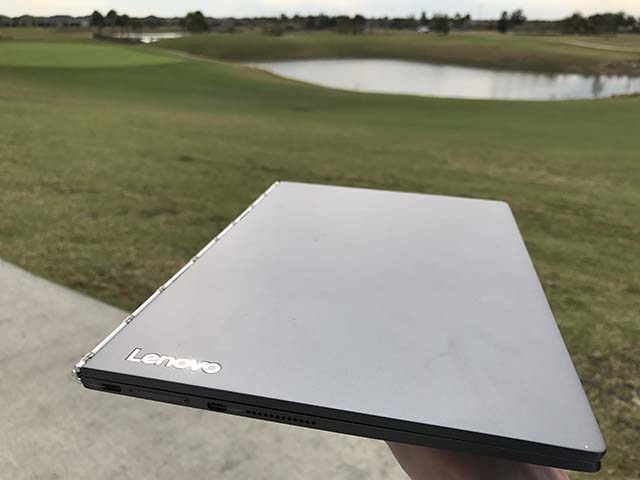
When the Yoga Book is open, we are looking at 2 black screens. The display has no plastic bezel, but rather an integrated glass bezel as usual with tablets and laptops/convertibles with a touchscreen. The keyboard area doesn’t have a single physical button anywhere. When looking closer, we can see the virtual keys and touchpad when the machine is turned off or in drawing/pen mode. When the Halo Keyboard is active, we get a glimpse of living in the future.
Halo Keyboard
Typing Experience
It is obvious that the typing experience will never be as great as a physical keyboard. This may be a deal breaker to some people. But there is more to the Yoga Book than meets the eye, which makes it worth your money. Let me explain. The Lenovo Yoga Book is technically a tablet with a 10.1” screen estate. Those that have already been using a tablet in the past, know that typing on a virtual keyboard is not comfortable either. Because you cannot hold the tablet with both hands and type at the same time. That is unless our thumbs would grow like Pinocchio’s nose.
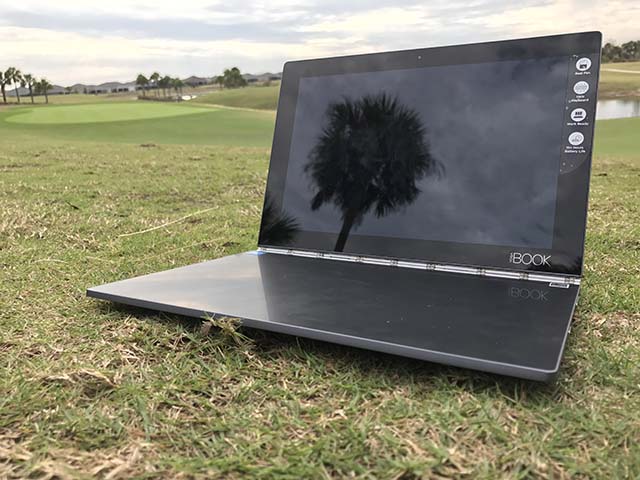 The Yoga Book on the golf course fields in The Villages (FL, U.S.)
The Yoga Book on the golf course fields in The Villages (FL, U.S.)
If Lenovo used a physical keyboard, the Lenovo Yoga Book would be considerably heavier and thicker. Also we wouldn’t have had the magnificent drawing pad.
Lenovo has put a lot of effort in optimizing the Halo Keyboard for a better typing experience. The space between the keys and the size of the keys is just about perfect for a 10.1” laptop. The touchpad however on Android needs a little work. Maybe it is too small for me coming from a full-sized ThinkPad T560 and MacBook Pro. Now I won’t get into details here, as Android is not meant to be used with a mouse.
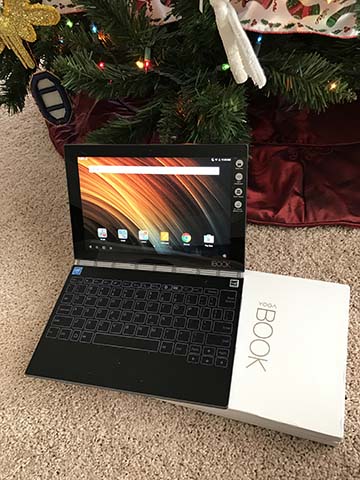 The beautiful Halo keyboard
The beautiful Halo keyboard
Drawing Experience
The drawing experience is superior to everything I have used in the past. When drawing on the keyboard area, you can feel the surface in your pen as if you were drawing with a pencil on a piece of paper. This is the most amazing thing I have ever felt since I started working as a software developer and haven’t used a real pencil or pen.
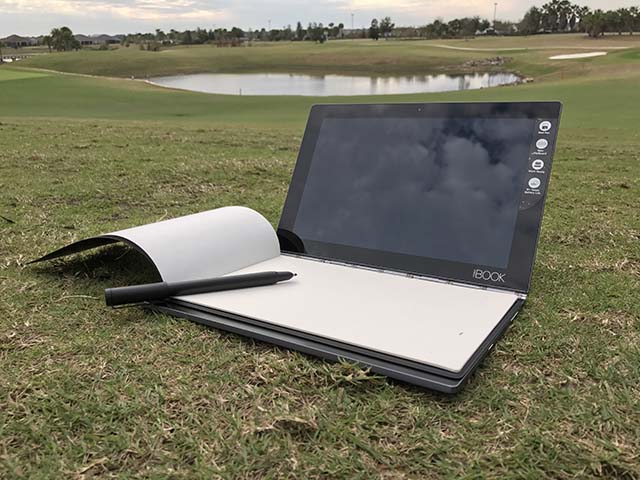 A work of art.
A work of art.
While drawing, your drawing won’t appear on the keyboard, but rather on your screen. The drawing pad overlays 100% with your screen. It’s also worth mentioning that third-party apps are compatible with the Yoga Book’s drawing pad. Lenovo has cleverly integrated the Halo Keyboard with the operating system.

In the box we also find actual paper sheets so you can overlay the sheet with the Halo Keyboard and get a physical copy as you are drawing. The book locks on the Halo keyboard with the magnets so it does not move while you are writing. Personally, I believe this might have some great applications in businesses. For example, if you’re buying a car and have to sign a contract. The car dealership will give you the copy and then has the digital copy for itself.
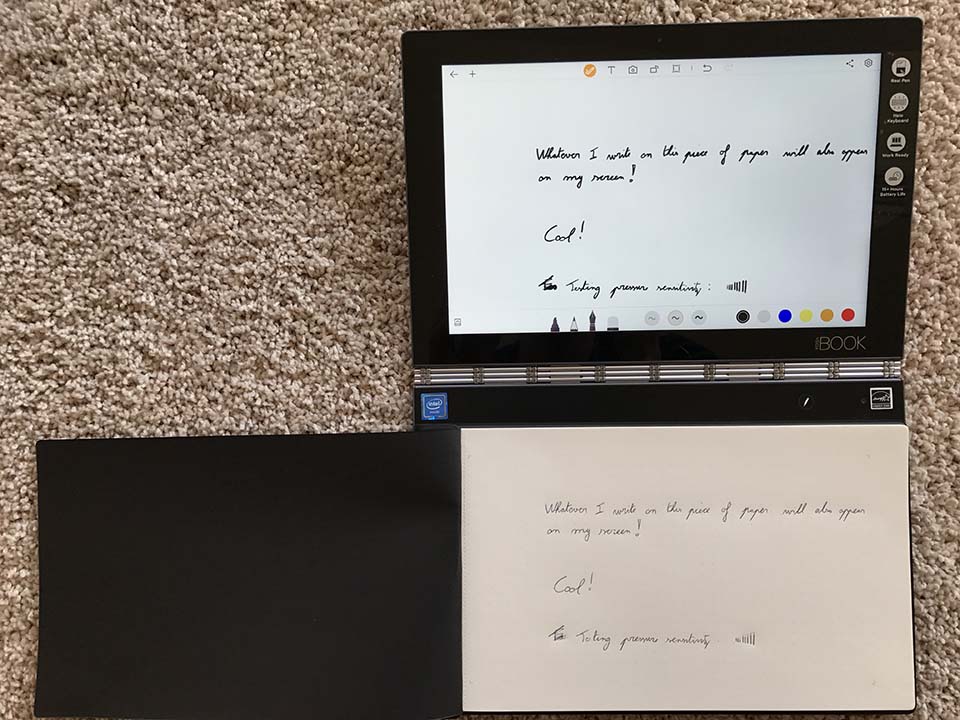 Writing on paper is mirrored on the screen.
Writing on paper is mirrored on the screen.
Display
Lenovo opted for a glossy display with a display resolution of 1920x1200 in the Yoga Book. The screen is vibrant and has a brightness of 401 nits. This is much higher than the average brightness of 319 nits for clamshell tablets.
Connectivity
You can expect up to 300 Mbps downlink and 50 Mbps uplink speeds for the WWAN and Wi-Fi. The WWAN model also supports the LTE-A standards meaning you have the best WWAN speeds possible assuming the radio towers for your carrier support this feature.
The Lenovo Yoga Book supports both 2.4 GHz and 5 GHz networks. For the best WiFi performance, make sure your router or access point supports:
-
802.11a
-
802.11ac
-
802.11b
-
802.11g
-
802.11n
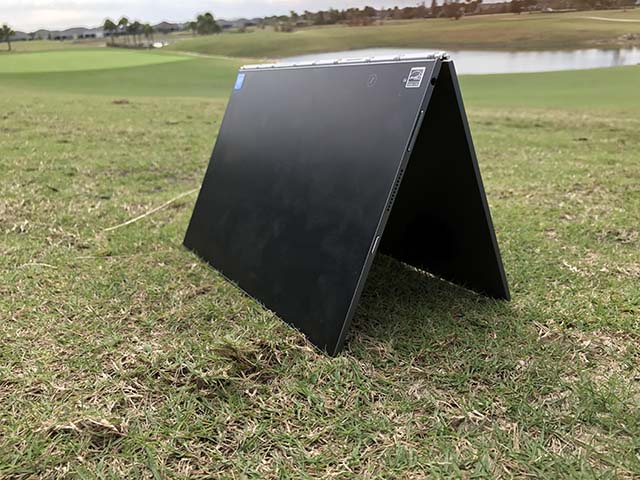 The Yoga Book in tent mode.
The Yoga Book in tent mode.
Ports
-
Micro-USB
-
Micro HDMI: Up to 3840x2160 (4K)
-
SIM slot (Nano SIM)
-
Micro SD slot
-
AUX port
Speakers
The quality of the speakers is slightly above the average in the tablet market and well above entry level laptops in the same price category. The volume is loud enough for watching your favorite TV series while showering.
Performance
The performance of the Lenovo Yoga Book isn’t one of the best, but it is not bad either. There is no stuttering to be seen anywhere, and performs perfect with all the drawing apps I have tried.
AnTuTu Benchmark
At the time of running the benchmark, the Lenovo Yoga Book made it to the 32nd position on the global ranking.
| Lenovo Yoga Book (Android) | 87260 |
| iPhone 7 Plus | 172644 |
| Xiaomi Mi Note 2 | 148352 |
| OnePlus 3 | 140288 |
| Huawei P9 | 91711 |
| Samsung Galaxy Note 5 | 83944 |
GFXBench
The Intel Atom x5-8550 appears to perform relatively well when compared with the latest flagship models from other manufacturers. Although its 3D performance is considerably lower.
| Lenovo Yoga Book | 452.1 |
| Samsung Galaxy S7 | 467 |
| Google Pixel XL | 664.4 |
| Google Pixel C | 694.8 |
| Xiaomi Mi 5s | 1100 |
| Google Pixel | 1179 |
Technical Information
Device
| Lenovo YB1-X90F |
| yeti_10_row_wifi * Codename * Screen size * Regional version * WiFi/WWAN |
| * W: 256.6 mm * D: 170.8 mm * H: 9.6 mm |
| 690 g / 1.52 lbs |
| 10.03 inches |
| 1920x1200 |
| 225 dpi |
| IPS |
| 400 nits |
| Yes, capacitive |
| 3850 MB LPDDR3 |
| 51.99 GB |
| Li-ion |
| 8500 mAh |
Software
| 6.0.1 (API 23) |
| 2016-10-01 |
| ART 2.1.0 |
| 3.1 |
| i686 |
| 3.14.55-x86_64 |
SoC
| Intel Atom x5-z8550 |
| 4 |
| x86 |
| Cherry Trail |
| 14 nm |
| 4 x 24 KB |
| 4 x 32 KB |
| 2 x 1024 KB |
| 480 MHz - 2.40 GHz |
| Interactive |
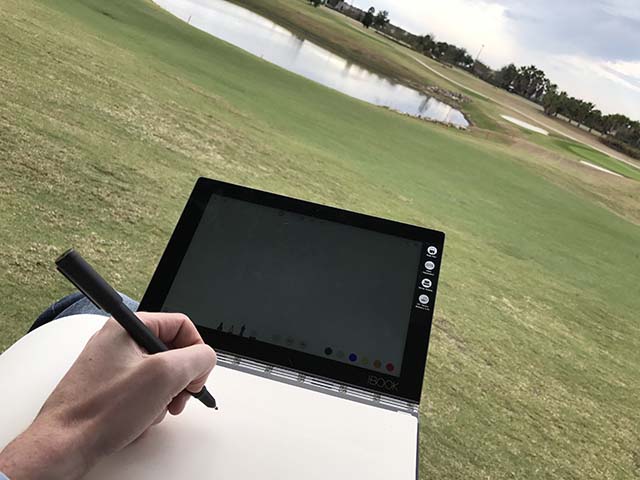
Verdict
With the tablet market currently being incredibly saturated and flat out boring, Lenovo came with a clever idea on how to make tablets and also laptops fun again. The new Halo keyboard will make typing on the 10 inch screen estate more comfortable for your short thumbs.
While the Android version is 50$ cheaper at 499$ MSRP, it is still fairly expensive for an Android tablet. But it is certainly worth your money. The Windows model comes at 549$ MSRP, and offers a lot if you are looking for an entry level laptop. Throw that cheap Acer in the thrash, and get yourself a beautiful Yoga Book for your travelling and creative needs.